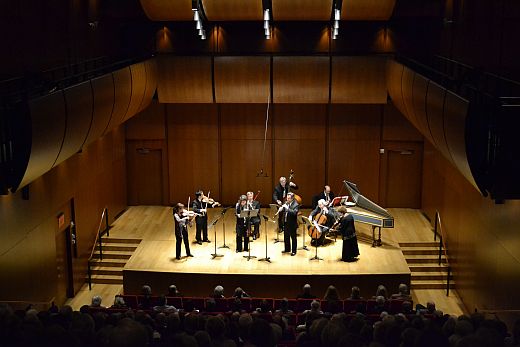 United States Biber, Albinoni, Bach St. Luke’s Chamber Ensemble, Krista Bennion Feeney (violin), Melanie Feld (oboe), Stephen Taylor (oboe), The Morgan Library & Museum, New York (12,17,19-10-2012) (SSM)
United States Biber, Albinoni, Bach St. Luke’s Chamber Ensemble, Krista Bennion Feeney (violin), Melanie Feld (oboe), Stephen Taylor (oboe), The Morgan Library & Museum, New York (12,17,19-10-2012) (SSM)
Biber: Sonata No. 3 in F major for Violin and Continuo, C. 140 (1681)
Tomasso Albinoni: Concerto for Two Oboes in C major, Op. 7, No. 11 (1715)
Bach: Violin Concerto in A minor, BWV 1041 (1717-1723)
Bach: Orchestral Suite No. 1 in C major, BWV 1066 (1717-1723)

Photo Courtesy: Orchestra of St. Lukes
When the best of the best get together to perform music they clearly love, a good time is guaranteed for all. The St. Luke’s Chamber Ensemble are members of the Orchestra of St. Luke’s which was founded in 1979. Since then they’ve recorded over seventy albums, won four Grammy Awards, commissioned over fifty new works and premiered over 150 new works. Both Ensemble and Orchestra have succeeded where so many others fail.
The Morgan Library concert consisted of two familiar works by Bach, one work by the under-appreciated Tomasso Albinoni and one by the recently revived master of the violin, Heinrich Biber. Sonata No. 3, like much of Biber’s music for violin, was written to show off his own virtuosic skills. Double-stopping, bariolage, emulation of bass ostinatos and pedal points are all techniques used here and in the other seven sonatas in this set of eight. No. 3 starts out with a praeludium, which could as well be called fantasia or toccata, an opening piece meant to sound as if it were improvised. The mixture of fast and slow runs leads without pause to a lovely group of variations. The final movement may sound familiar as it has a repeating ground similar to Pachelbel’s Canon. Although marked as Variatio, it is really a poignant chaconne, one of the common rhythmic forms popular in Europe at the time. Best of all was the surprise ending: the piece stops in the middle of a violin riff.
Krista Bennion Feeney’s performance was a showcase of violin technique. Her approach to the Biber sonata achieved the right mix between Romantic vibrato and cool Baroque style, and technical difficulties, of which there were many, didn’t seem to faze her. It was both captivating and convincing, and on a par with performances of the work by violinists such as Andrew Manze and John Holloway.
Vivaldi or Albinoni? It’s really difficult to tell, not only in the Albinoni piece performed here, but in any of his concerti. An older contemporary of Vivaldi, born seventeen years before him and living ten years longer, Albinoni clearly influenced the younger composer. The concerto played here is part of the earlier of two sets of twelve concerti, most for oboe. This demanding work was deftly played by Melanie Feld and Stephen Taylor. As in the previous piece, modern instruments were played in a persuasive Baroque style, but I did miss the warm and mellow coloring of period oboes.
Ms. Feeney returned for another solo role in Bach’s A minor violin concerto. A challenge for performers of works that have been overplayed through the years is the need to take the audience back to the time when these compositions still sounded fresh. With their vivacity and elan, the St. Luke’s Chamber Ensemble was able to revivify both this work and the Bach Orchestral Suite No. 1 that followed.
The group covered the orchestral requirements of this suite in a one-instrument-per-part format. This could have produced a thin sound, but through a combination of performance volume and the fine acoustics of the Morgan’s theater, the musical voices were full and distinct. There was a slightly humorous moment when the final notes of the concluding Passepied,a generally slow dance, ended. The audience wasn’t quite sure if the suite had indeed finished: our usual expectation with Bach is that his works end with a gigue or a similar quick tempo.
Stan Metzger